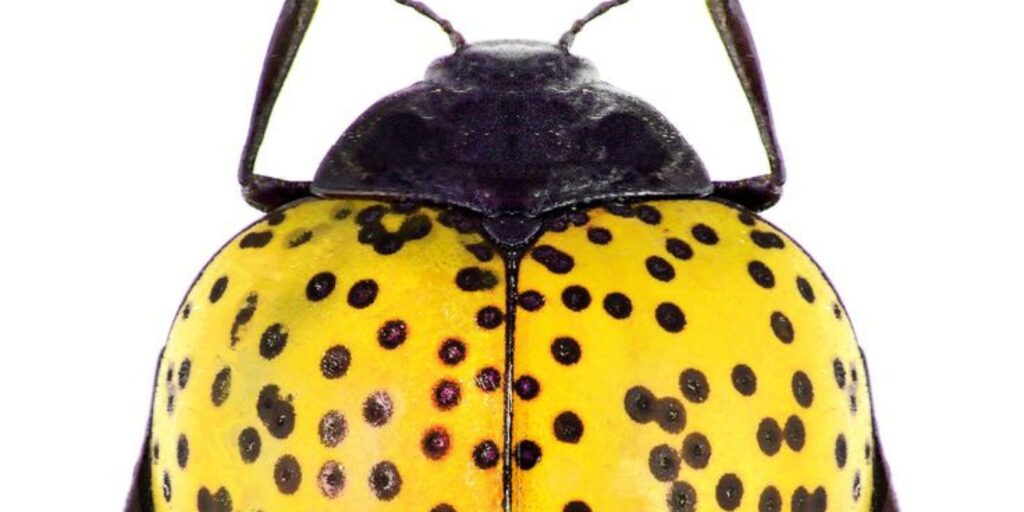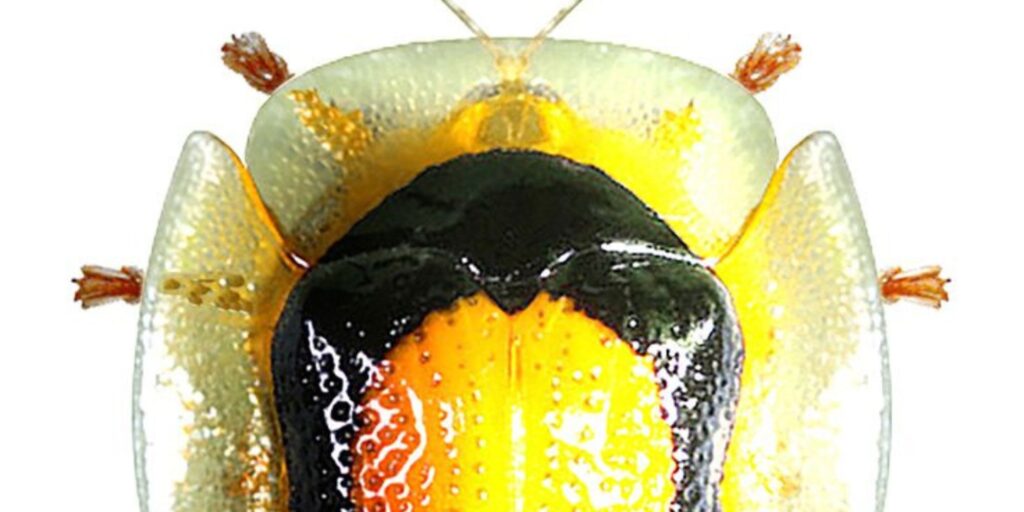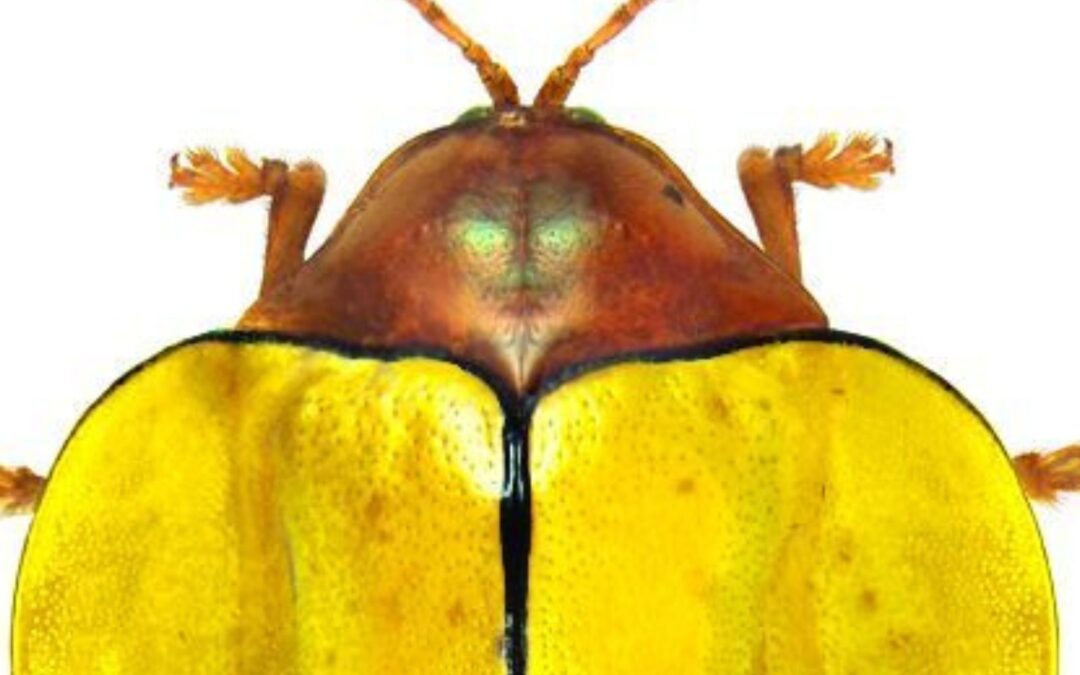A yellow beetle is a small insect characterized by its vibrant yellow coloring, which can sometimes include patterns or markings that vary depending on the species. These beetles belong to various families, with some of the most common being members of the Cucujidae and Chrysomelidae families. Yellow beetles are found in a variety of habitats, from gardens and forests to grasslands and wetlands, where they contribute significantly to the health of the ecosystem. While their size may vary, most yellow beetles are relatively small, with some species measuring just a few millimeters in length, while others can grow larger.
Yellow beetles play a crucial role in pollination, helping to transfer pollen from one flower to another as they feed on nectar or pollen. This process is essential for the reproduction of many plants, including those that are important for food production. Additionally, yellow beetles help in nutrient recycling by feeding on decaying organic matter, such as dead leaves and wood. Their digestive processes break down this material, returning valuable nutrients to the soil, which in turn supports plant growth.
Although yellow beetles may go unnoticed by many, they are a vital part of nature’s intricate web, supporting biodiversity and maintaining ecological balance. Their bright yellow color not only makes them fascinating to observe but also serves as a reminder of the important, often overlooked, roles insects play in the environment.
What is a yellow beetle? : Common Types of Yellow Beetles

Several types of beetles are known for their yellow appearance. Here are a few of the most commonly encountered species:
- Cucumber Beetle
Cucumber beetles are small, and yellow beetles are often seen in gardens. They usually have black spots or stripes on their back. These beetles are notorious for being agricultural pests, especially for cucumbers, squashes, and melons. They chew on leaves and stems, but their most damaging trait is spreading bacterial wilt, a disease that can destroy crops.
- Lady Beetle Varieties (Ladybugs)
Not all ladybugs are red with black spots! Some varieties, like the Yellow-Lady Beetle or 22-Spot Ladybug, display a bright yellow body with black spots. These beetles are helpful because they predate pests like aphids, making them a gardener’s ally.
- Golden Tortoise Beetle
True to its name, the golden tortoise beetle has a shell-like body that shimmers in metallic gold, though it sometimes appears yellow. This beetle primarily feeds on plants in the morning glory family, and its color can change depending on its mood or health.
- Spotted Pine Sawyer Beetle (Yellow Variant)
Some variants of this beetle species display striking yellow bodies, often with a pattern of black spots. They’re typically found on pine trees, where they can cause damage by boring into the wood.
- Common Yellow Soldier Beetle
Yellow soldier beetles are long, slender insects with soft bodies and pale yellow coloration. They are often found on flowers and feed on nectar and pollen, and they are considered harmless to plants.
What is a yellow beetle? : Appearance and Characteristics

Yellow beetles are often easily identified due to their distinctive color, but they vary greatly depending on the species. Here are some common features they typically share:
- Coloration: A vibrant yellow shell with additional spots, stripes, or markings in black or other colors.
- Size: Most yellow beetles are small, ranging from a few millimeters to about an inch in length.
- Body Structure: Like all beetles, they have a hard exoskeleton, wings, and a three-part body (head, thorax, and abdomen).
Some beetles use their vivid coloration to warn predators that they may taste unpleasant or are harmful to eat. The color acts as camouflage for others, helping them blend into flowers or fruits.
What is a yellow beetle? : Habitat and Distribution
Yellow beetles inhabit a wide range of environments across the world. Here’s where you’re most likely to find them:
- Gardens: Many species, like the cucumber beetle, can be found among vegetables, fruits, and flowering plants.
- Forests: Some species live in trees or among decaying wood.
- Fields and Meadows: Open areas full of flowers, grasses, and crops are hotspots for beetles seeking food and mates.
- Urban Areas: It’s common to find yellow beetles near decorative plants or parks.
These insects are highly adaptable, which has contributed to their widespread presence.
What is a yellow beetle? : The Role of Yellow Beetles in Ecosystems
Yellow beetles, like many insects, play important roles within ecosystems:
- Pollination
Some yellow beetles, such as the soldier beetle, are pollinators. They help plants reproduce by feeding on nectar and pollen.
- Pest Control
Certain species, like yellow ladybugs, feed on plant pests like aphids, helping reduce the need for chemical pesticides.
- Nutrient Cycling
Beetles involved in wood decomposition or feeding on organic matter contribute to soil nutrient cycling, enhancing soil health.
- Food Source for Predators
Yellow beetles are an essential food source for birds, spiders, and other predators, supporting the food chain.
What is a yellow beetle? : Challenges Associated with Yellow Beetles
While some species of yellow beetles are beneficial, others can pose challenges:
- Crop Damage
Species like the cucumber beetle target crops, causing extensive damage to leaves, flowers, and stems. Farmers often have to use pesticides or companion planting to manage infestations.
- Tree and Plant Damage
Certain beetles bore into trees, leading to weakened structures and sometimes the death of the plant.
- Pest Control Dilemmas
Managing harmful beetle populations without harming beneficial ones, like pollinators, requires strategic pest-control practices.
How to Support Beetle-Friendly Habitats
If you’d like to encourage the growth of beneficial yellow beetles in your area while minimizing pests:
- Plant Native Flowers
Attract pollinating beetles by planting native flowering plants that provide them with nectar and pollen.
- Limit Pesticide Use
Opt for natural pest-control methods to avoid harming harmless or helpful beetle species.
- Create Beetle Habitats
Leave small patches of leaf litter, fallen wood, or undisturbed soil to support beetle biodiversity.
- Monitor Crops Closely
If you’re a gardener or farmer, regularly inspect your plants for signs of beetle activity and take early action against pest species.
An Important Part of Nature’s Web
Though small in size, yellow beetles hold an essential place in nature’s intricate web. These vibrant insects contribute to a variety of ecological processes, from pollination to nutrient cycling. Despite their often-overlooked presence, yellow beetles have a lasting impact on the environment, helping maintain balance in ecosystems that support a wide range of plant and animal life.
The Pollination Power of Yellow Beetles
One of the key roles yellow beetles play in the environment is pollination. As they move from flower to flower in search of food, they transfer pollen, facilitating plant reproduction. This process is crucial for the growth of many plants, including those that humans rely on for food. The next time you notice a yellow beetle on a blooming flower, you can be sure it’s contributing to the thriving ecosystem around you.
Contributing to Nutrient Cycles
In addition to pollinating plants, yellow beetles also play a critical role in the breakdown of organic matter. By feeding on decaying leaves, wood, and other organic materials, they help decompose and recycle nutrients back into the soil. This natural process enriches the earth, ensuring that plants have access to the nutrients they need to grow, thus supporting a healthy ecosystem.
Admiring Their Beauty
While yellow beetles may be working hard behind the scenes, they also offer a moment of wonder with their striking appearance. Their vivid yellow color, often accompanied by intricate patterns, adds beauty to the natural world. Seeing a yellow beetle buzzing around your garden or local park is a reminder of the diversity and stunning variety of life in our ecosystems.
Spotting Yellow Beetles in Your Garden
Yellow beetles are often found in gardens and natural environments, particularly during the warmer months. Their vibrant yellow color makes them easy to spot as they move through flowers and plants. If you’re lucky enough to encounter one, take a moment to observe its movements and behavior. You may notice how they interact with the plants they visit, helping to pollinate flowers or contribute to the overall health of the garden. By becoming more observant, you can recognize yellow beetles and appreciate their role in nature.
Yellow Beetles’ Role in Pollination
One of the key ecological contributions of yellow beetles is their role in pollination. As they feed on nectar and pollen, they transfer pollen from one flower to another, aiding in plant reproduction. This process is essential for the production of fruits, seeds, and new plants, making yellow beetles crucial for maintaining the health and biodiversity of many gardens and wild habitats. Understanding their pollination behavior can deepen your appreciation for these beetles and the broader ecosystem they support.
The Beauty of Yellow Beetles in Nature
Beyond their functional role in the ecosystem, yellow beetles are also a stunning sight to behold. Their striking color and intricate patterns make them stand out against the green backdrop of plants. Their beauty reminds us of the intricate details that make nature so fascinating. Next time you see a flash of yellow in your garden, take a moment to admire not only the beetle’s appearance but also the many layers of life that surround it.
A World Full of Fascinating Insects
Yellow beetles are just one example of the extraordinary diversity of insects that populate our planet. From pollinators to decomposers, insects contribute in numerous ways to the balance of ecosystems. By learning more about these tiny creatures, we gain insight into the interconnectedness of life and the importance of even the smallest organisms. The next time you spot a yellow beetle, take it as an opportunity to reflect on the countless other insects that share our environment and help maintain its health.
Protecting the Habitat of Yellow Beetles
To ensure that yellow beetles and other beneficial insects thrive, it’s important to protect their habitats. Gardeners and nature enthusiasts can make small changes, such as planting native plants, reducing pesticide use, and creating welcoming spaces for insects. By fostering healthy environments, we can support the survival of these fascinating creatures and their essential role in the ecosystem. Every action counts in preserving the delicate balance of nature.
Understanding Insect Conservation

As we learn more about insects like yellow beetles, we also become more aware of the need for insect conservation. Many insect species are facing threats due to habitat loss, climate change, and pesticide use. By supporting conservation efforts and creating insect-friendly spaces in our gardens, we can contribute to the survival of these important creatures. Understanding their life cycle, behavior, and role in ecosystems is the first step toward becoming a better steward of the natural world.
In conclusion, yellow beetles are a captivating and vital part of nature. By recognizing their beauty and understanding their role in the environment, we can appreciate the important work insects do to keep our ecosystems healthy and balanced. Keep an eye out for these fascinating creatures the next time you’re in the garden, and take a moment to reflect on the

